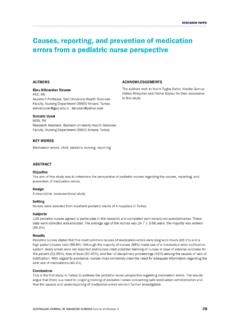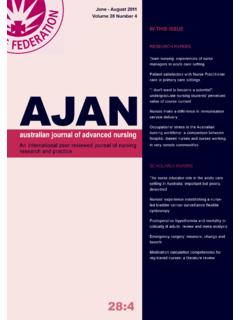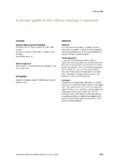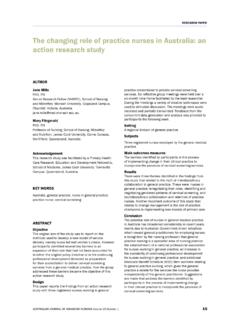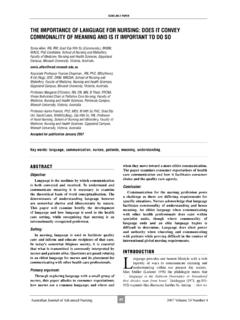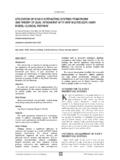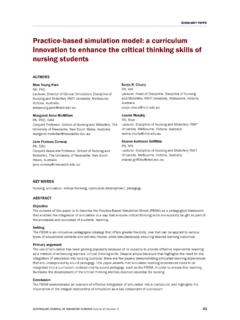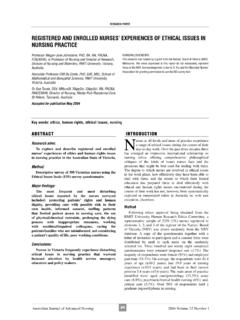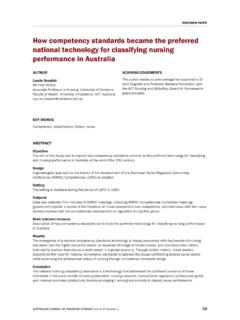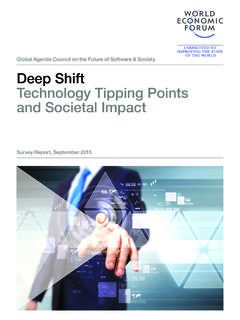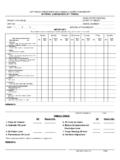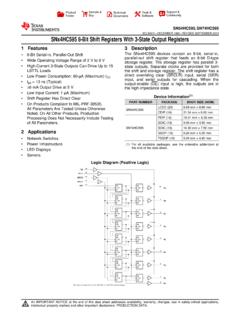Transcription of The impact of shift work on people’s daily health habits ...
1 AUSTRALIAN JOURNAL OF ADVANCED NURSING Volume 25 Number 38 AUTHORS Isabella ZhaoRN, BN (Hons) School of Nursing, The University of Queensland, Australia. Catherine TurnerRN, BA, Grad Dip Ed, MN, PhD Associate Professor, School of Nursing, The University of Queensland, Australia. research on which this paper is based was conducted as part of the Nurses and Midwives e cohort study, The University of Queensland, Australia. We acknowledge the funding support of the Australian Research Council, the National health and Medical Research Council, Queensland health and The Department of health South work, diet, BMI, smoking, exercise, alcoholThe impact of shift work on people s daily health habits and adverse health outcomesABSTRACTO bjectiveTo review the published scientific literature for studies analysing the association between shift work and people s daily health habits (as measured by diet, exercise, smoking or alcohol consumption) and adverse health outcomes such as following selection criteria were used to systematically search the literature: the studies were to be primary observational or analytical in design; targeted populations were working adults engaged in shift work; and outcome measures were the association between shift work and either diet, exercise, BMI, smoking or alcohol consumption.
2 Data extraction and quality assessment were performed independently by the two authors using a standardised procedure. Synthesis of data is presented in text and tabular format. Meta analysis was not possible due to the heterogenic nature of the studies review retrieved seventeen studies that met all inclusion criteria. The majority of the studies found that shift workers had more adverse lifestyle behaviours. Compared to non shift workers, the nutritional intake of shift workers is less healthy and they are more likely to smoke when compared to non shift workers. shift workers also tend to be overweight. The impact of shift work on exercise patterns and alcohol consumption could not be ascertained because of the paucity of high quality work impacts negatively on daily health habits and can lead to adverse health outcomes, such as poor dietary intake, smoking, and becoming overweight. The majority of Australian health care workers, and in particular nurses, work rotating shifts .
3 It is important to have a greater understanding of the impact of shift work on our health care PAPERAUSTRALIAN JOURNAL OF ADVANCED NURSING Volume 25 Number 39 INTRODUCTIONM odern society is moving toward a pattern of working twenty four hours a day. Essential services provided by police departments, fire brigades, ambulance officers and hospital employees have traditionally always operated throughout a twenty four period. Increasingly other services such as restaurants, petrol stations, and grocery/convenience stores are open twenty four hours in order to accommodate night workers (Geliebter et al 2000). Over the last several decades, there has been a rapid increase in the number of shift workers worldwide (Sudo and Ohtsuka 2001). In Australia in 2003, a national survey found that over one million employees (14%) had worked shift work in the previous four weeks.
4 Of these shift workers, 46% had worked a rotating shift (ABS 2004). health and community services have the second highest proportion of shift workers of any industry in Australia ( : ABS 2004). The health workforce is estimated to be about 7% of the entire Australian workforce and nurses comprise the single largest health professional group (54%: Productivity Commission 2006).As people work irregular hours, their daily routine is interrupted. Regular eating and exercise habits are difficult to maintain (Geliebter et al 2000). Consequently, shift workers have a higher prevalence of being overweight (Chee et al 2004; Sudo and Ohtsuka 2001). In addition, shift workers also have more adverse life style behaviours, such as higher tendency to smoke (Reeves et al 2004) and drink alcohol (Nakamura et al 1997). These daily habits (diet, exercise, smoking and alcohol consumption) and their immediate consequences (eg obesity) are the fundamental causes of many chronic diseases (Mcginnis and Foege 1993).
5 An unhealthy diet often leads to being overweight and contributes to circulatory diseases, diabetes mellitus and various forms of cancer (Vuori 1998). Lack of exercise is closely associated with food related ill health (Nestle and Jacobsson 2000). A person who is obese is at greater risk of cardiovascular risk factors (Orzano and Scott 2004). Cigarette smoking has been identified as a classical risk factor for coronary heart disease (Kannel et al 1987). Alcohol consumption also increases the risk of chronic disease (Rehm et al 2006). The impact of shift work on people s daily health habits and adverse health outcomes should be well majority of nurses in Australia are working rotating shifts in order to provide twenty four hour health care. Current nursing shortages warrant investigation of all possible factors that affect nurses health and daily lives. Nursing workforce shortages are acknowledged globally.
6 In Australia, there was an estimated shortfall of between to 12,000 nurses in 2006 and between 10,000 and 13,000 in 2010 (Productivity Commission 2006). One of the factors associated with nursing retention is shift work, particularly night shift (Cooper 2003). The aim of this paper is to systematically review the evidence in the published scientific literature that quantifies and examines the association between shift work and daily health habits that lead to adverse health databases were searched using EBSCO host as a search engine for CINAHL (1982 2006), pre CINAHL (2006), health Source: Nursing/Academic Edition (1975 2006), and MEDLINE (1966 2006). The following six separate search terms were used: shift work AND health ; shift work AND diet; shift work AND exercise; shift work AND BMI; shift work AND smoking; shift work AND combined effort of the above searches produced 601 abstracts.
7 On examination of the study titles and abstracts by the two authors, 33 articles were retrieved. Rejected abstracts did not meet the study selection criteria. The references of these retrieved articles were also examined. A snowballing strategy of reference titles was used and related abstracts and/or full text articles were databases were searched using the above terms (except the first one) including: PubMed, PsycInfo and Proquest health and medical complete. However only Proquest health and medical complete yielded another two relevant articles. The Cochrane library was also searched with no relevant literature PAPERAUSTRALIAN JOURNAL OF ADVANCED NURSING Volume 25 Number 310 Overall, 35 full text articles were retrieved and assessed by the two authors independently, using the following selection criteria for this study:1. S t u d i e s we r e to b e p u b l i s h e d , p r i m a r y research;2.
8 Study designs were to be observational and/or analytical (cross sectional; case control or prospective cohort studies);3. The targeted populations were working adults engaged in shift work; and4. Outcome measures were the association between shift work and either diet, exercise, BMI, smoking or alcohol studies met all the inclusion criteria for this review. Assessment for the quality of the methodology of these studies was based on a standardised abstraction procedure (Centre for Reviews and Dissemination 2001). The eighteen excluded articles are shown in table 1 with the reasons for exclusion. The results of selected studies are outlined in table 1: Studies retrieved but not selectedFirst author (year)Reason for exclusionFujino et al (2006)Outcome measure was the risk of ischemic heart disease rather than the et al (2006)No report of outcome measure of the association between shift work and BMI.
9 Persson and Martensson (2006)Not a primary analytical study. A qualitative descriptive design with a Critical Incident Technique (2005)A retrospective cohort study examining the health influences of alcohol consumption, smoking and eating habits on increased serum GGT. It is unclear whether the subjects were engaged in shift et al (2005)Exposure measure was smoking status rather than shift et al (2005)Exposure measures were sleep problems and recent life events rather than shift et al (2005)Not a primary analytical research. An experimental study on the effects of shift workers consumption of test meals on alertness (2004)Not a primary analytical research. A review of et al (2004)Outcome measure was the association between different working schedules and sleep and Stone (2004)Not a primary analytical (2002)Not a primary analytical research. A review of the (2001)Not a published article.
10 A PhD (1999)Outcome measure was the association between long working hours and health rather than the association between shift work and et al (1998)Outcome measure was the joint effect of shift work and certain adverse life style factors on coronary heart disease rather than the association between shift work and those adverse life style factorsChou (1997)Not a published research article. A PhD and Berry (1997)Not an observational study. A serial repeated measures design whereby each subject served as his own s et al (1995)An intra group comparison of the 24 hour nutrient intake and the intake of coffee and tea between days off and work days in day workers; or between days in shift cycle in two shift workers; or between days in shift cycle in three shift workers. No inter group comparison between these three et al (1990)Outcome measure was the association between shift work and physical health and mental PAPERAUSTRALIAN JOURNAL OF ADVANCED NURSING Volume 25 Number 311 RESULTSThis review found seventeen studies that met all inclusion criteria.
